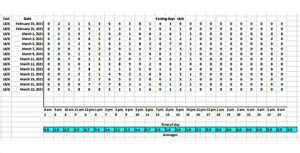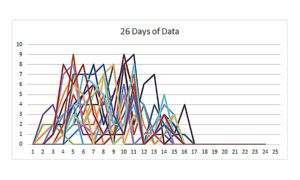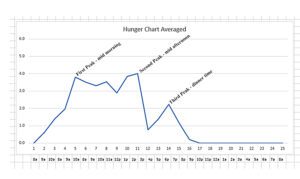Do you ever feel like you’re always hungry? Millions of dieters around the world struggle with hunger every day. But there is a way to understand your appetite and create a plan that fits your lifestyle. Hunger can be rated on a scale from 1-10, with 10 being the most hungry you have ever been in your life. Once you understand how to rate your hunger, it will be easier to decide when and what to eat, and when to fast.
The Hunger Scale

0 Not hungry.
1-3 Very mild hunger, easy to tolerate.
4-6 Stomach growls. Hunger is strong but tolerable.
7-10 Stomach growls constantly and intensely, feel ravenous, may have symptoms of fasting flu.
The need for a hunger scale.
Hunger can come at any time and at different levels. How do you know when to eat and when to fast? You can develop a hunger profile by rating and recording your hunger once per hour over 24 hours for a few days or more. With the data, you can build a hunger profile that fits you and your lifestyle. Most people, roughly 80%, find they are most hungry in the afternoon and early evening, while the other 20% find that hunger is highest in the morning.
Applying the Hunger Scale
The hunger scale can give you a tool to profile your hunger throughout the day. In reality, you can use it to estimate the level of ghrelin your body is secreting. You can use this information to determine when you may need to plan for some fasting support. You can plan to be very busy, out for a walk or doing some activity when you are most likely to get to a moderate or severe level of hunger.
Note: If you are new to fasting and leave the house, ensure you have plenty of water and some low-carb snacks, just in case.
Step 1. Daily Data Collection Chart
The first step is data collection, this example is with a spreadsheet, but you can also use a notebook to record your information. Keep the notebook close by and record your hunger level at the end of each hour. Record the hours you sleep as 0. The following example is a person following a fasting plan of 18 hours of fasting with a 6-hour eating window – 18/6.

Step 2. The next step is to graph your data.
Graph of All Data – our graph is interesting as a work of abstract art but not helpful in understanding our hunger or ghrelin cycle.

Step 3. Graph of Average
So, by averaging the data, we get a much clearer picture of the time-of-the day this individual is most hungry.

Based on the data, we suggested that when fasting, she should start by opening her eating window at 10 am and closing it at about 3 or 4 pm. However, this was too inconvenient with her work schedule. We then suggested that she eat a large breakfast and a light lunch, but with travel time to work, this proved difficult.
Ultimately, she decided to skip breakfast and lunch and open her eating window around 5 pm. Due to her natural hunger cycles, Phase 1 of our program was a little hard for her, but over time she reports she has adjusted very well, her hunger cycles now match her new lifestyle, and she has lost a significant amount of weight.
Many things influence how hungry you feel and when you feel hungry: work schedules, your family, your habits, your attitude, and most of all, your biology. We tend to get hungry about 3 times per day. Like the hills and valleys on a rollercoaster, hunger swells and then recedes. Every few hours, hunger peaks and slowly drops back down over a 15 to 20-minute period. By understanding how your body works, i.e., when you become hungry, you are in a much better position to determine when to eat and fast.
Quick Review
Insulin – makes us store fat
Ghrelin – is the hunger hormone
Leptin – tells us when we are full or satisfied
Determining when you are most hungry will help in scheduling your fasting day.
Regular Features
This Week’s Diet and Lifestyle Q&A, Yes or No: For effective diets, the best advice is, “Eat frequent small meals all day long.”
Food for Thought – Interested in reducing the high fructose corn sweetener (HFCS) in your diet but don’t know where to start? Try the organic foods section of the grocery store. For example, we now use Red Duck Katchup, which has no HFCS, and we have found that it has a much richer tomato flavor than regular commercial ketchup. Low HFCS and great taste – a win, win!
Trouble Shooting
Fasting flu is very similar to Keto flu or motion sickness. It can include fatigue, headache, dizziness, balance problems, or nausea. Many new fasters experience this, but in time, they learn when to listen to their bodies and to stop fasting before it gets serious. With experience, you will know when to push a little longer or stop fasting. Do not confuse fasting flu with normal hunger pangs. Here are some solutions to lessen or relieve the symptoms.
1. Ion imbalance – need to drink water with a pinch of sea salt.
2. Hunger levels are too high – need to eat a serving of whole food.
3. Long term, you may need to adjust your fasting periods.
4. If symptoms do not subside or worsen, seek medical attention immediately.
5. If this is a medical emergency, call 911 immediately.
The good news is that fasting flu symptoms diminish very quickly when treated with food, including low-carb foods.
Be safe and be happy.
Jim
For more information, email us at:
New: Check out our YouTube channel at:
https://www.youtube.com/channel/UCeycoyo7yT1rLPMzt3s_f-Q
This Week’s Diet and Lifestyle Q&A, Yes or No: For effective diets, the best advice is, “Eat frequent small meals all day long.”
Answer: No. This plan keeps your insulin levels high all day long, which blocks the body’s ability to burn fat. It may work for a lucky few, but for 99.5%, it does not work. Intermittent fasting works by creating a few hours each day when your insulin level is very low, and you transition to burning your stored fat to fuel your body.
For great, Love This Diet approved low carb snacks go to:
https://www.ebay.com/str/lpantiquesandcollectables/Diet-Fasting-Health/_i.html?store_cat=37740949014



